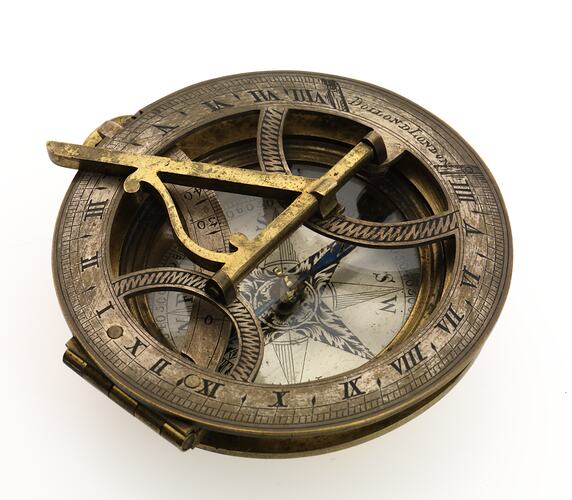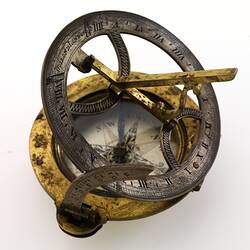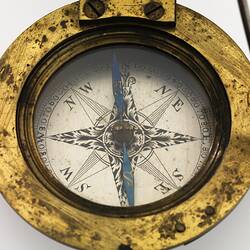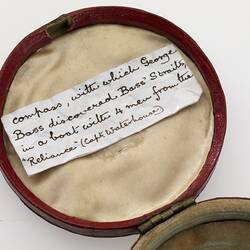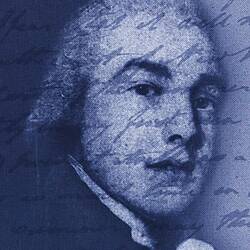Summary
Pocket compass sundial used by George Bass on the whaleboat expedition that explored the coast of Victoria as far as Westernport Bay, 1797-98.
The expedition provided the first European sighting of Wilsons Promontory and suggested the existence of Bass Strait separating Tasmania from the Australian mainland.
The pocket compass and sundial was manufactured in London by the eminent optical instrument maker Peter Dollond. After its use by Bass it was passed on through the family of Elizabeth Waterhouse, Bass' wife, before being purchased at auction in 1998 by Victorian surgeon William F. Wilson as part of an extensive collection relating to George Bass.
Physical Description
Pocket compass sundial. The sundial made of brass, is moveable with a moveable arm that is hinged to the top of the compass. The compass is made of both brass and steel and has a glass lid and blue coloured dial.
Significance
This compass is a unique item of national significance to the early maritime exploration of Australia and in particular the Victorian coastline and Tasmania.
The compass was used by George Bass and his crew of six on the expedition in an unnamed whaleboat from Sydney to Westernport Bay between December 1797 and February 1798. This was the first European voyage to explore the Victorian coastline between Point Hicks and Westernport Bay. Notable features include the first European sighting of Wilsons Promontory, and the discovery and naming of Westernport Bay. The length of the voyage undertaken in an open boat, over 3000 kilometres, made Bass's skills in navigation and seafaring highly regarded at the time.
The voyage provided the strongest evidence to date that Tasmania was an island, separate from the mainland. Bass actually attempted a crossing of the strait on this voyage south of Wilsons promontory but bad weather forced him to turn back. Together with Matthew Flinders' separate voyage to the Furneaux Islands in February 1798, the whaleboat voyage prompted the mission to circumnavigate Tasmania undertaken by Bass and Flinders in the Norfolk between October 1798 and January 1799. After this voyage Flinders proposed naming the strait between Tasmania and the mainland Basses Strait (later Bass Strait) in honour of his friend's whaleboat voyage.
The provenance of the pocket compass and sundial before the whaleboat journey is not known, however presumably it travelled to New South Wales in 1795 aboard either the Reliance or the Supply. The pocket compass returned to England with George Bass in 1800. It then came into the possession of Elizabeth Waterhouse, who married Bass in September 1800, along with a note from Henry Waterhouse, captain of the Reliance, explaining the significance of the object. The compass was passed on through this family until sold at auction in 1998.
More Information
-
Collecting Areas
-
Acquisition Information
Cultural Gifts Donation from Dr Meaghan Wilson-Anastasios, Ms Victoria Wilson, Mr Adrian Dubar, 22 Nov 2011
-
Acknowledgement
Donated in the memory of William F. Wilson by the Wilson-Anastasios, Wilson and Dubar families. Donated through the Australian Government's Cultural Gifts Program.
-
Manufacturer
Peter & John Dollond, London, England, Great Britain, circa 1790
-
User
-
Previous Collection
-
Classification
-
Category
-
Discipline
-
Type of item
-
Overall Dimensions
65 mm (Width), 70 mm (Depth), 21 mm (Height)
-
Overall Dimensions
75 mm (Width), 75 mm (Height)
Dimensions for compass with moving parts extended.
-
Dimensions
65 mm (Width), 21 mm (Height)
Measurement From Conservation. The dimensions of the compass are 65 x 21 mm and the dimensions of the associated box is 75 x 75 mm
-
Keywords
Compasses, Exploration, Navigation, Navigation Instruments, Sundials
